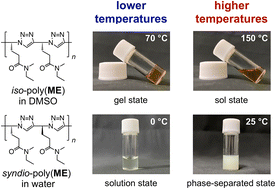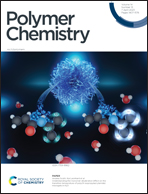Contrasting thermoresponsiveness of stereoisomers of a dense 1,2,3-triazole polymer carrying amide side chains†
Abstract
Since thermoresponsive polymers are an important class of smart polymer materials, it is an important subject of investigation to develop thermoresponsive polymers with a new polymer backbone for expanding their potential. Recently, we synthesized poly(N-ethyl-N-methyl-4-azido-5-hexynamide) (poly(ME)) by copper(I)-catalyzed azide–alkyne cycloaddition (CuAAC) polymerization as a new lower-critical-solution-temperature (LCST) type thermoresponsive polymer. In this study, we synthesized two types of stereoregular poly(ME) (i.e., isotactic and syndiotactic) by CuAAC polymerization of ME dimers of the R- and R-isomers, and the R- and S-isomers, respectively, and investigated their thermoresponsive behavior. Binary mixtures of isotactic poly(ME) (iso-poly(ME)) with dimethyl sulfoxide (DMSO) and with N,N-dimethylformamide (DMF) underwent thermoresponsive gel-to-sol transition, in which the mixture turned from gel to sol at a certain temperature as the temperature was increased. On the other hand, aqueous solutions of syndiotactic poly(ME) (syndio-poly(ME)) underwent the LCST-type phase transition, in which the solution was transparent at lower temperatures whereas it became turbid at a certain temperature as the temperature was increased.

- This article is part of the themed collection: Trends in Thermoresponsive Polymers: from Chemistry to Applications


 Please wait while we load your content...
Please wait while we load your content...